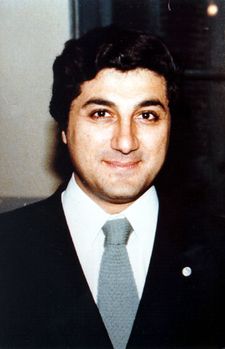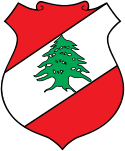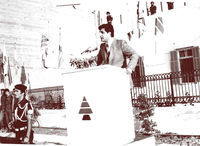Bachir Gemayel
| Bachir Pierre Gemayel | |
 |
|
|
President-elect of Lebanon
|
|
|---|---|
| In office August 23, 1982 |
|
| Preceded by | Elias Sarkis |
| Succeeded by | Amine Gemayel |
|
|
|
| Born | November 10, 1947 Achrafieh, Beirut |
| Died | September 14, 1982 (aged 34) Achrafieh, Beirut |
| Political party | Lebanese Forces |
| Spouse(s) | Solange Totonji |
| Religion | Maronite Catholic |
| Lebanon |
 This article is part of the series: |
|
|
|
Constitution
Presidency
Legislature
Political parties
Elections
Other issues
|
|
Other countries · Atlas |
Bachir Gemayel (10 November 1947 – 14 September 1982) (first name also spelled Bashir and surname also spelled al-Jumayyil, El Gemaiel, Joomayyeel) (بشير الجميّل) was a Lebanese politician, militia commander, and president-elect. He was a senior member of the Phalange party and the commander of the Lebanese Forces militia amid the first several years of the Lebanese Civil War (1975-90). He was elected president on August 23, 1982 while the country was torn by civil war and occupied by both Israel and Syria. He was assassinated on September 14, 1982, along with 26 others, when a bomb exploded in the Beirut headquarters of the Phalange. The bomb was planted by Habib Tanious Shartouni.[1] The FBI blamed the Syrian Social Nationalist Party.[2]
Contents |
Early life
Bachir was born on November 10, 1947 in the Achrafieh neighborhood of Beirut, the youngest of six children. The Gemayel family is originally from the Bikfaya village in the Matn District of Lebanon and is one of the most influential Christian families in Lebanon. His father was Pierre Gemayel, who founded the Phalange party in 1936 as a youth movement. The Phalange, a conservative party that though is officially secular, is supported mostly by Maronite Christians. Bachir joined the Phalange in 1962 as a member of its student sector. Gemayel attended College de Notre Dame de Jamhour and the Lebanese Modern Institute (Institut Moderne du Liban in Fanar). He completed his formal university education at St. Joseph University (Université Saint-Joseph - U.S.J.) in Beirut. After teaching for three years at the Lebanese Modern Institute, he graduated in 1971 with a degree in Law and another in Political Sciences in 1973. In 1971, Gemayel also took another law qualification from the American and International Law Academy in Dallas, Texas. Qualifying in 1972, he joined the bar association and opened an office in Hamra, West Beirut. In 1968, he participated in a student colloquium organized by the newspaper Orient, following events which occurred across Lebanese universities between the Islamic and leftist students supporting Palestinians in Lebanon on one side, and Lebanese and nationalist students (who Bachir represented) on the other. [3]
Militia command
In 1970, Bachir was briefly kidnapped by Palestinian militants in Lebanon and taken to the Tel al-Zaatar refugee camp. He was released 8 hours later. Then in 1971, Bachir was appointed as an inspector of the military branch of the Phalange, who formed a militia to counter the influence of what they saw as a growing Palestinian threat to Lebanon.
With tensions rising between the Palestinian Liberation Organization, which was based in Lebanon, and numerous Christian Lebanese parties, among them the Phalange, clashes broke out on several occasions. The PLO gained support from many Lebanese, in particular Sunni Muslims, Druze, and leftists. These pro-Palestinian Lebanese formed the Lebanese National Movement. In 1975, two Phalangists accompanying Pierre Gemayel were killed when unidentified gunmen, assumed to be Palestinian militants in a speeding car, fired at them. This was seen as an attempt on the life of Phalangist leader Pierre Gemayel. Consequently, the Phalangists, led by Bachir, retaliated hours later by ambushing a bus carrying 27 Palestinians and killed them. This sparked the Lebanese Civil War. Later in 1975, Gemayel was accused by the LNM of being responsible for the Black Saturday massacre of Palestinians and Lebanese Muslims. According to Phalange member Karim Pakradouni, Bachir admitted that while being in an emotional state for the killing of four Phalangists earlier that day, he ordered his militiamen into the streets. Bachir claimed that when the situation developed into something he did not agree with and civilians were being killed, he tried to stop the killings but failed to.[4]
In 1976, with the death of William Hawi, Bachir became head of the Phalangist militia. Later that year, he became a leading member of the Lebanese Front, a coalition of several Christian parties, and commander of their main militia, the Lebanese Forces. The militia not only opposed the PLO but also the Syrian troops, who had entered Lebanon at first to assist in defeating Palestinian militants, before turning into occupiers. Bachir led his troops in the infamous “Hundred Days War” in Lebanon in 1978, in which the Lebanese Forces successfully resisted the Syrian shelling and attacking of Eastern Beirut for about three months before an Arab-brokered agreement made the Syrians end the siege. At this time, Israel was the primary backer of the Lebanese Front’s militia.
Tensions within the Lebanese Front
Despite their increasing success in their battle against the PLO, the Syrian troops, and their Lebanese allies, factors led to the Lebanese Front’s demise. On June 13, 1978, following the killing of a senior Phalangist by members of the Marada militia, which was led by fellow member of the Lebanese Front, Tony Frangieh, Bachir sent a squadron of his miltia, led by Samir Geagea and Elie Hobeika to Ehden in order to bring Franjieh to retaliate the attack. Frangieh, several members of his militia, and his family were vacationing in the Northern Lebanese town of Ehden. There is much controversy and diverse versions of what happened next, but by the end of the attack, Frangieh, his family, and several of his militiamen were dead. It is believed that the main objective was to kidnap Tony Frangieh and force him to surrender his militia, but the squadron was faced by military opposition, resulting in over 30 deaths. Among the dead were Frangieh, his wife, daughter, and several Marada militiamen. Samir Geagea was also injured, prior to showing up to the Frangieh residence. The Marada movement left the Lebanese Front soon after.
In 1980, in an attempt to unify the Lebanese Forces under his direct command and in what he dubbed Unification of the Rifle, Bachir sent his troops to the town of Safra, where Dany Chamoun and members of his Tigers militia were vacationing. With full support from Dany’s father, former president Camille Chamoun, the Tigers under the control of Elias el Hannache were exterminated in what was later named Safra massacre. Dany’s life was spared and he sought refuge in West Beirut, but Camille Chamoun’s support of the attack was interpreted as him believing that his son’s militia was getting too out of control.
Israeli invasion of Lebanon and Bachir's election
Israel invaded Lebanon in 1982. Defense Minister of Israel, Ariel Sharon, met with Bachir months earlier, telling him that the Israeli Defense Force were planning an invasion to uproot the PLO threat to Israel and to move them out of Lebanon. [5] While Bachir did not control Israel’s actions in Lebanon, the support they gave the Lebanese Forces, militarily and politically, angered many Lebanese Muslims and leftists.
The PLO was rooted out of Lebanon in August of 1982. By now, Bachir had announced his candidacy for president. He was backed by the United States, who sent peacekeeping troops to oversee the withdrawal of the PLO from Lebanon. Bachir had requested that they stay longer to keep Lebanon stable until he could reunite it, but his request was denied. On August 23, 1982, being the only one to declare his bid, Bachir was elected president.
On 1 September 1982, two weeks before his assassination and only one week after his election, Bachir met the Israeli Prime minister Menachem Begin in Nahariya. Begin demanded that Bachir sign a peace treaty with Israel as soon as he took office in return of Israel's earlier support of Lebanese Forces. Begin was reportedly angry at Bachir for his public denial of Israel's support. Bachir refused the immediate peace arguing that time is needed to reach consensus with Lebanese Muslims and the Arab nations. Bachir was quoted telling David Kimche, the director general of the Israeli Foreign Ministry, few days earlier, “Please tell your people to be patient. I am committed to make peace with Israel, and I shall do it. But I need time - nine months, maximum one year. I need to mend my fences with the Arab countries, especially with Saudi Arabia, so that Lebanon can once again play its central role in the economy of the Middle East.”[6][7]
Assassination

On September 14, 1982, Bachir was addressing fellow Phalangists at their headquarters in Achrafieh for the last time as their leader and for the last time as commander of the Lebanese Forces. He was discussing how the militia would transfer its military power to the Lebanese Army, which Bachir hoped to support as the only military power in Lebanon. At 4:10 PM, a bomb was detonated at the headquarters, killing Bachir and 26 other Phalange politicians. Whereas rumors spread that Bachir had gotten out alive, it was confirmed the next morning by the Lebanese Prime Minister Shafik Wazzan that Bachir was indeed assassinated. [8]
Habib Shartouni, a member of the Syrian Social Nationalist Party and also a Maronite Christian, was later arrested for the assassination. His sister was living in the apartment above the room Bachir was in. He had visited her the previous day and planted the bomb in her apartment. The next day, he called her and told her to get out of the building. Once she was out, he detonated the bomb from a few miles away from the building. When he came back to check on his sister, he was immediately arrested. He later confessed to it, saying he had done this because “Bachir had sold the country to Israel.” He was imprisoned for 8 years, until Syrian troops took over Lebanon at the end of the war and freed him on October 13, 1990.[9]
Condemnations poured in from around the world, including from the United Nations Security Council in Resolution 520 as well as from American President Ronald Reagan. Reagan had been one of Bachir's most staunch supporters, saying "this promising young leader had brought the light of hope to Lebanon."[10]
Various theories exist as to other parties that had a hand in the assassination. Many point fingers at the Syrian government and then-Syrian President Hafez al-Assad for having knowledge of the assassination attempt and for backing Shartouni. [11] Another theory claims that Israel secretly ordered the assassination after they began to feel Bachir was going to delay the process of peace between Lebanon and Israel and rather wait for Arab backing and Lebanese consensus on the issue. Even after they kept pressuring him, Bachir refused to immediately give Israel peace. [12]
Following Bachir's death, furious Christian militiamen under Elie Hobeika from the Lebanese Forces carried out the Sabra and Shatila massacre. Israel surrounded the Palestinian refugee camps and let the Phalangists in. Additionally on Hobeika's orders, Shartouni's father, mother and uncle were murdered by the Lebanese Forces in retaliation.[13]
Bachir Gemayel's older brother Amine Gemayel was then elected as president, serving from 1982 to 1988. Rather different in temperament, Amine Gemayel was widely regarded as more moderate than his brother. Many of Bachir's followers were dissatisfied with Amine. Eventually, the Lebanese Forces became independent from the Phalange and its own political party.
Family
Gemayel's widow, Solange Gemayel, works to keep his legacy alive through the Bachir Gemayel Foundation, a political and informational organization.
Gemayel's first daughter Maya was murdered in 1980 at 18 months of age by a car bomb intended for Gemayel himself. [14] He has two surviving children: His second daughter, Youmna, was born later in the year and received her degree in political science in Paris. She is now working towards her Masters in Management at ESA (École supérieure des affaires) in Beirut. Gemayel's son, Nadim, who was born months before Bachir was killed, was a law student and political activist, and was elected as a member of the Lebanese Parliament in 2009.
See also
- Kataeb Party
- Lebanese Forces
- Pierre Gemayel
- Samir Geagea
- Waltz with Bashir
References
Jean-Marc ARACTINGI,La Politique à mes trousses( Politics at my heels), Editions l'Harmattan, Paris, 2006,Lebanon Chapter (ISBN 978-2-296-004696).
- ↑ Reuters (1982-10-03). "Phalangists identify bomber of Gemayel as lebanese leftist". The New York Times. http://query.nytimes.com/gst/fullpage.html?res=9E0DE0DB1F38F930A35753C1A964948260&scp=1&sq=Shartouni&st=cse.
- ↑ Neil A. Lewis (1988-05-18). "U.S. Links Men in Bomb Case To Lebanon Terrorist Group". The New York Times. http://query.nytimes.com/gst/fullpage.html?res=940DE6D81039F93BA25756C0A96E948260&n=Top/Reference/Times%20Topics/Subjects/B/Bombs%20and%20Explosives.
- ↑ http://www.bachirgemayel.org/index.php?option=com_content&task=view&id=43&Itemid=75
- ↑ http://video.google.com/videoplay?docid=-1361306345209781470&hl=en
- ↑ http://www.youtube.com/watch?v=g29PR3nkZPc
- ↑ President Reagan and the World By Eric J. Schmertz, Natalie Datlof, Alexej Ugrinsky, Hofstra University
- ↑ Special to the New York Times (1982-09-04). "Begin Said to Meet in Secret With Beirut's President-Elect". The New York Times. http://query.nytimes.com/gst/fullpage.html?res=9F06EED71438F937A3575AC0A964948260&sec=&spon=. "Begin Said to Meet in Secret With Beirut's President-Elect"
- ↑ From Beirut to Jerusalem by Thomas Friedman
- ↑ http://www.bachirgemayel.org/index.php?option=com_content&task=view&id=66&Itemid=71
- ↑ Statement on the Assassination of President-elect Bashir Gemayel of Lebanon
- ↑ http://wars.meskawi.nl/people.html#9
- ↑ "The New Lebanon Crisis". Time. September 27, 1982. http://www.time.com/time/magazine/article/0,9171,925735-4,00.html. Retrieved April 26, 2010.
- ↑ Robert Hatem, From Israel to Damascus, chap.8
- ↑ Special to The New York Times (1980-02-24, Sunday). "Beirut Bomb Kills 8; Christian Militia Chief Believed to Be Target; Fought Palestinians and Leftists". The New York Times: p. 10. http://select.nytimes.com/gst/abstract.html?res=F40E12FD3E5410728DDDAD0A94DA405B8084F1D3&scp=2&sq=Maya%20Gemayel&st=cse.
External links
- Bachir Gemayel Community Site (Bachir Gemayel Foundation site)
- Liberty Front presents President Bachir Gemayel
- Lebanese Forces Resistance Official Website
|
|||||||||||